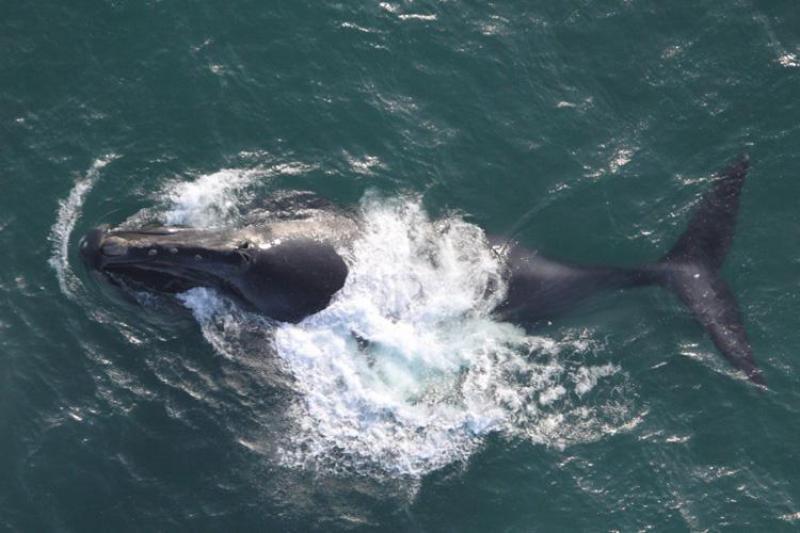
NOAA Fisheries to revise critical habitat for right whales in Alaska
by NOAA Fisheries 5 Oct 2023 17:41 UTC

North Pacific Right Whale © NOAA Fisheries
NOAA Fisheries has concluded that a revision of endangered North Pacific right whale critical habitat is warranted. We intend to proceed with a revision, including initiating the rulemaking process. There are only an estimated 30 eastern North Pacific right whales remaining.
Our decision is in response to a petition we received on March 10, 2022, from the Center for Biological Diversity and Save the North Pacific Right Whale. It requested that we revise the critical habitat designation for the species.
Critical habitat for North Pacific right whales was designated in 2008. It consists of two areas, one in the Southeast Bering Sea, the other in the Gulf of Alaska off the coast of Kodiak Island (Figure 1). The areas are approximately 35,460 square miles and 1,175 square miles, respectively.
The petition requests we revise critical habitat to connect the two existing critical habitat areas. This would entail extending the Southeast Bering Sea boundary west and south to the Fox Islands, through Unimak Pass to the edge of the continental slope. It would also extend east to the Gulf of Alaska critical habitat area off the coast of Kodiak Island. We have not yet decided whether to propose the specific revision recommended by the petitioners or some other revision to the critical habitat designation.
What's next? the process to revise critical habitat
On July 12, 2022, we published a positive 90-day finding that the petitioned revision may be warranted. We also initiated a review of currently designated critical habitat and solicited public comments during a 60-day period.
We conducted a review of the petition using the best scientific data available. We also considered information we received during the comment period. Our review indicates that a revision to North Pacific right whale habitat is warranted.
To identify what areas qualify as critical habitat for this species, we will conduct and analysis and synthesis of:
- Available acoustic mooring data
- Visual sightings
- Observations of right whale feeding behavior
- Spatial and temporal patterns in right whale prey
We will also consider potential economic, national security, and any other relevant impact of designating any particular areas as critical habitat.
Based on the data supporting critical habitat, we will then revise the critical habitat. We will develop a proposed rule that will undergo public comment and a final rule that addresses information and comments received during the comment period.
North Pacific Right Whale Critical Habitat
North Pacific right whales are one of the rarest of all large whale species. Scientists estimate that only about 30 individuals remain in the eastern North Pacific population. They have been listed as endangered under the Endangered Species Act since 1973.
In May 2008, we issued a final rule designating critical habitat for North Pacific right whales in the Gulf of Alaska and the Southeast Bering Sea.
At the time of designation, there were significant gaps in the knowledge of North Pacific right whale biology and ecology. We did not have much information about the physical and biological habitat features that might be essential for their conservation.
However, we examined whales harvested during the whaling era and plankton tows conducted near feeding whales. This taught us that several species of large copepods and other zooplankton constitute the primary prey of North Pacific right whales diet. The physical and biological features identified for North Pacific right whales in 2008 were copepods in areas where right whales are known or thought to feed.
We also concluded it is likely that certain physical forcing mechanisms are present in these areas that act to concentrate the identified prey species in densities which allow for efficient foraging by right whales.
What's new since the original designation
New information has been collected since critical habitat was initially designated in 2008. It provides a better understanding of North Pacific right whale movements and habitat use.
North Pacific right whales have been detected in and around currently designated critical habitat. Acoustic moorings detected North Pacific right whale calls across all years and seasons from 2009 to 2015 in Unimak Pass in the Aleutian Islands, which is not currently designated critical habitat.
North Pacific right whales were seen for the first time during winter just outside Unimak Pass in February 2022. Four North Pacific right whales were seen in the Gulf of Alaska in August 2021. One pair was actively feeding in the currently designated critical habitat area off Kodiak Island and the second pair was outside of critical habitat, about 100 miles to the west of where the first pair was sighted.